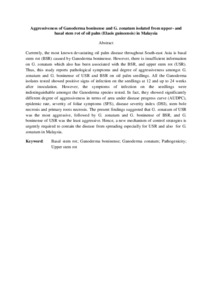Citation
Rakib, M. R. M. and Bong, C. F. J. and Khairulmazmi, A. and Idris, A. S.
(2015)
Aggressiveness of Ganoderma boninense and G. zonatum isolated from upper- and basal stem rot of oil palm (Elaeis guineensis) in Malaysia.
Journal of Oil Palm Research, 27 (3).
pp. 229-240.
ISSN 1511-2780
Abstract
Currently, the most known devastating oil palm disease throughout South-east Asia is basal stem rot (BSR) caused by Ganoderma boninense. However, there is insufficient information on G. zonatum which also has been associated with the BSR, and upper stem rot (USR). Thus, this study reports pathological symptoms and degree of aggressiveness amongst G. zonatum and G. boninense of USR and BSR on oil palm seedlings. All the Ganoderma isolates tested showed positive signs of infection on the seedlings at 12 and up to 24 weeks after inoculation. However, the symptoms of infection on the seedlings were indistinguishable amongst the Ganoderma species tested. In fact, they showed significantly different degree of aggressiveness in terms of area under disease progress curve (AUDPC), epidemic rate, severity of foliar symptoms (SFS), disease severity index (DSI), stem bole necrosis and primary roots necrosis. The present findings suggested that G. zonatum of USR was the most aggressive, followed by G. zonatum and G. boninense of BSR, and G. boninense of USR was the least aggressive. Hence, a new mechanism of control strategies is urgently required to contain the disease from spreading especially for USR and also for G. zonatum in Malaysia.
Download File
![[img]](http://psasir.upm.edu.my/43678/1.hassmallThumbnailVersion/Aggressiveness%20of%20Ganoderma%20boninense%20and%20G.%20zonatum%20isolated%20from%20upper-%20and%20.pdf)  Preview |
|
Text (Abstract)
Aggressiveness of Ganoderma boninense and G. zonatum isolated from upper- and .pdf
Download (5kB)
| Preview
|
|
Additional Metadata
Actions (login required)
 |
View Item |

